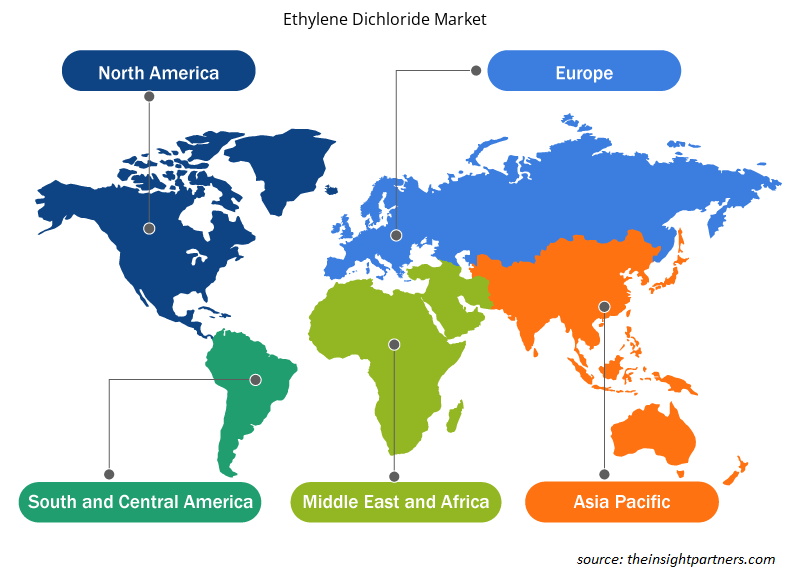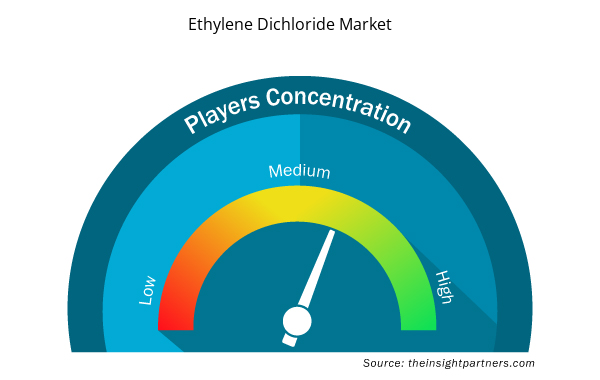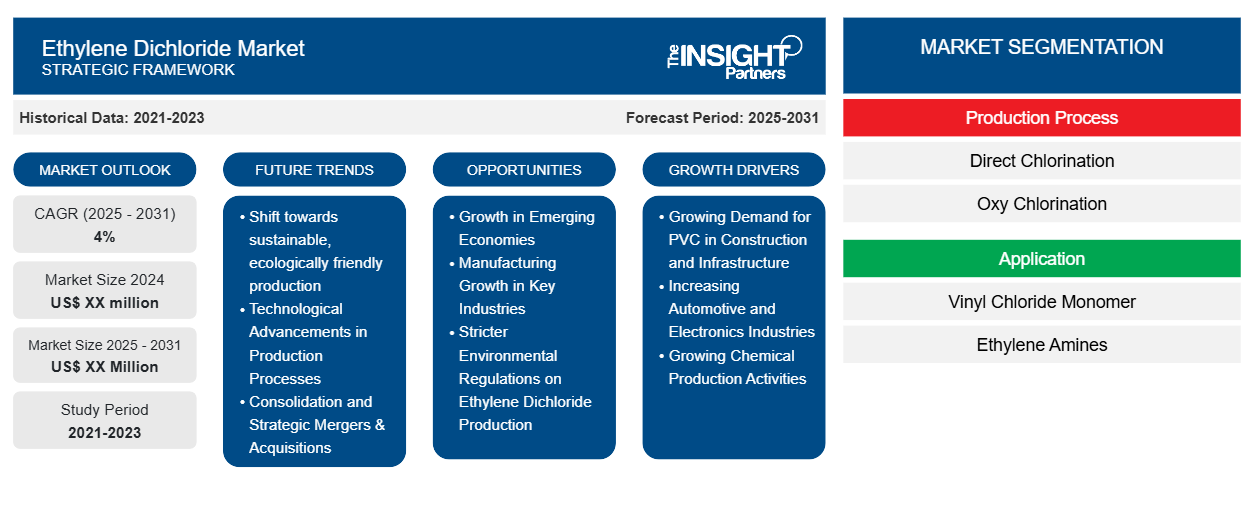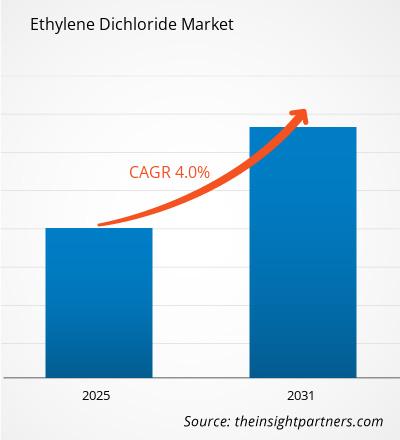Le marché du dichlorure d'éthylène devrait enregistrer un TCAC de 4 % de 2024 à 2031, avec une taille de marché passant de XX millions USD en 2024 à XX millions USD d'ici 2031.
Le marché du dichlorure d'éthylène couvre l'analyse par processus de production (chloration directe, oxychloration) ; application (monomère de chlorure de vinyle, amines d'éthylène, autres) et géographie (Amérique du Nord, Europe, Asie-Pacifique, Moyen-Orient et Afrique, et Amérique du Sud et centrale). Le dichlorure d'éthylène est un hydrocarbure chloré qui est un liquide incolore. Le dichlorure d'éthylène est également connu sous le nom de 1,2-dichloroéthane. Le dichlorure d'éthylène est souvent utilisé dans la production de monomère de chlorure de vinyle qui est utilisé dans les tuyaux en PVC, les meubles et les garnitures d'automobiles, les revêtements muraux, etc. Pour la production industrielle de dichlorure d'éthylène, la réaction entre l'éthane et le chlore est effectuée en présence de chlorure de fer (III) comme catalyseur.
Objectif du rapport
Le rapport sur le marché du dichlorure d'éthylène de The Insight Partners vise à décrire le paysage actuel et la croissance future, les principaux facteurs moteurs, les défis et les opportunités. Cela fournira des informations à diverses parties prenantes commerciales, telles que :
- Fournisseurs/fabricants de technologie : pour comprendre l’évolution de la dynamique du marché et connaître les opportunités de croissance potentielles, leur permettant de prendre des décisions stratégiques éclairées.
- Investisseurs : Effectuer une analyse complète des tendances concernant le taux de croissance du marché, les projections financières du marché et les opportunités qui existent tout au long de la chaîne de valeur.
- Organismes de réglementation : Réglementer les politiques et surveiller les activités du marché dans le but de minimiser les abus, de préserver la confiance des investisseurs et de maintenir l’intégrité et la stabilité du marché.
Segmentation du marché du dichlorure d'éthylène
Processus de production
- Chloration directe
- Oxychloration
Application
- Monomère de chlorure de vinyle
- Amines d'éthylène
Personnalisez ce rapport en fonction de vos besoins
Vous bénéficierez d'une personnalisation gratuite de n'importe quel rapport, y compris de certaines parties de ce rapport, d'une analyse au niveau des pays, d'un pack de données Excel, ainsi que d'offres et de remises exceptionnelles pour les start-ups et les universités.
- Obtenez les principales tendances clés du marché de ce rapport.Cet échantillon GRATUIT comprendra une analyse de données, allant des tendances du marché aux estimations et prévisions.
Facteurs de croissance du marché du dichlorure d'éthylène
- Demande croissante de PVC dans la construction et les infrastructures : L'un des principaux facteurs de croissance du marché des EDC est la demande croissante de PVC dans la construction et les infrastructures. Le PVC est largement utilisé comme matériau de construction, notamment pour les tuyaux, les fenêtres, les portes, les revêtements de sol et les toitures. Avec l'augmentation des investissements dans les infrastructures des économies émergentes, la demande de PVC augmente et, à son tour, entraîne le besoin d'EDC, le précurseur clé de la fabrication du PVC. Cette augmentation de la demande pour les projets de construction devrait encore propulser le marché du dichlorure d'éthylène.
- Croissance des secteurs automobile et électronique : le dichlorure d'éthylène est essentiel à la production d'une large gamme de produits en plastique. Il est utilisé dans les secteurs automobile et électronique. La demande de matériaux plus légers et plus résistants dans la fabrication automobile et de pièces en plastique sophistiquées dans l'électronique a ouvert un marché important pour l'EDC. À mesure que ces industries se développent dans le monde entier, la demande de dichlorure d'éthylène restera forte et soutiendra la croissance du marché.
- Croissance des activités de production chimique : L'industrialisation en cours et l'expansion des activités de fabrication dans les économies émergentes, principalement en Asie-Pacifique et en Amérique latine, créent une demande continue de dichlorure d'éthylène. L'EDC est une matière première dans la fabrication de nombreux produits chimiques tels que le VCM, un précurseur du PVC. L'augmentation des capacités de production chimique dans ces mêmes régions continue de fournir une base pour soutenir la demande de dichlorure d'éthylène.
Tendances futures du marché du dichlorure d'éthylène
- Transition vers une production durable et respectueuse de l'environnement : les réglementations environnementales devenant de plus en plus strictes à travers le monde, le marché du dichlorure d'éthylène connaît une tendance vers des méthodes de production plus durables. Les fabricants se concentrent sur la réduction de l'empreinte carbone et l'amélioration de l'efficacité énergétique dans la production d'EDC. Par exemple, la transition vers l'utilisation de matières premières renouvelables et l'adoption de processus de production plus propres prend de l'ampleur en réponse aux objectifs mondiaux de durabilité.
- Progrès technologiques dans les procédés de production : Les nouvelles technologies de production améliorent l'efficacité de la production de dichlorure d'éthylène. Les innovations en matière de craquage catalytique et les procédés de craquage optimisés ont permis d'augmenter les rendements et l'efficacité énergétique. À mesure que ces technologies continuent de progresser, elles réduisent les coûts et améliorent la rentabilité des fabricants, ce qui stimulera la croissance du marché dans les années à venir.
- Consolidation et fusions et acquisitions stratégiques : ces dernières années, les principaux acteurs du marché des EDC ont procédé à des fusions, des acquisitions et des coentreprises pour élargir leurs portefeuilles et acquérir un avantage concurrentiel. Cette tendance à la consolidation améliore la capacité de production des entreprises, rend les chaînes d'approvisionnement plus efficaces et ouvre de nouveaux marchés, en particulier dans les régions émergentes qui connaissent une hausse de la demande de produits chimiques.
Opportunités de marché du dichlorure d'éthylène
- Croissance dans les économies émergentes : La demande de matériaux de construction tels que le PVC augmente avec les investissements en infrastructures dans les économies émergentes. La demande de dichlorure d'éthylène augmente dans les substances susmentionnées car il est considérablement utilisé dans la production de PVC. Avec l'augmentation des projets de construction de routes, de bâtiments et de services publics dans ces régions, la demande pour ce produit va donc augmenter.
- Croissance de l'industrie manufacturière dans les secteurs clés : Un contexte industriel sain renforce la demande de produits chimiques. Elle est alimentée par l'augmentation des activités manufacturières dans des secteurs comme l'automobile et l'électronique, qui ont stimulé la demande de dichlorure d'éthylène, améliorant la production de divers segments de plastique pour la dynamique soutenue du marché.
- Réglementation environnementale plus stricte sur la production de dichlorure d'éthylène : une réglementation environnementale plus stricte aurait probablement une incidence sur la quantité de dichlorure d'éthylène produite et utilisée. Une réglementation plus stricte pourrait augmenter les coûts des mesures de conformité, rendant à terme difficile la disponibilité du dichlorure d'éthylène, et pourrait, en même temps, orienter la production vers des pratiques ou des alternatives plus respectueuses de l'environnement dans l'industrie chimique.
Aperçu régional du marché du dichlorure d'éthylène
Les tendances régionales et les facteurs influençant le marché du dichlorure d’éthylène tout au long de la période de prévision ont été expliqués en détail par les analystes d’Insight Partners. Cette section traite également des segments et de la géographie du marché du dichlorure d’éthylène en Amérique du Nord, en Europe, en Asie-Pacifique, au Moyen-Orient et en Afrique, ainsi qu’en Amérique du Sud et en Amérique centrale.

- Obtenez les données régionales spécifiques au marché du dichlorure d'éthylène
Portée du rapport sur le marché du dichlorure d'éthylène
| Attribut de rapport | Détails |
|---|---|
| Taille du marché en 2024 | XX millions de dollars américains |
| Taille du marché d'ici 2031 | XX millions de dollars américains |
| Taux de croissance annuel composé mondial (2024-2031) | 4% |
| Données historiques | 2021-2023 |
| Période de prévision | 2025-2031 |
| Segments couverts | Par processus de production
|
| Régions et pays couverts | Amérique du Nord
|
| Leaders du marché et profils d'entreprises clés |
|
Densité des acteurs du marché du dichlorure d'éthylène : comprendre son impact sur la dynamique commerciale
Le marché du dichlorure d'éthylène connaît une croissance rapide, tirée par la demande croissante des utilisateurs finaux en raison de facteurs tels que l'évolution des préférences des consommateurs, les avancées technologiques et une plus grande sensibilisation aux avantages du produit. À mesure que la demande augmente, les entreprises élargissent leurs offres, innovent pour répondre aux besoins des consommateurs et capitalisent sur les tendances émergentes, ce qui alimente davantage la croissance du marché.
La densité des acteurs du marché fait référence à la répartition des entreprises ou des sociétés opérant sur un marché ou un secteur particulier. Elle indique le nombre de concurrents (acteurs du marché) présents sur un marché donné par rapport à sa taille ou à sa valeur marchande totale.
Les principales entreprises opérant sur le marché du dichlorure d'éthylène sont :
- Société Formosa Plastics
- Société chimique occidentale
- Prochem, Inc.
- PT Asahimas Chimie
- SABIC
Avis de non-responsabilité : les sociétés répertoriées ci-dessus ne sont pas classées dans un ordre particulier.

- Obtenez un aperçu des principaux acteurs clés du marché du dichlorure d'éthylène
Principaux arguments de vente
- Couverture complète : Le rapport couvre de manière exhaustive l’analyse des produits, des services, des types et des utilisateurs finaux du marché du dichlorure d’éthylène, offrant un paysage holistique.
- Analyse d’experts : Le rapport est compilé sur la base d’une compréhension approfondie des experts et analystes du secteur.
- Informations à jour : Le rapport garantit la pertinence commerciale en raison de sa couverture des informations récentes et des tendances des données.
- Options de personnalisation : ce rapport peut être personnalisé pour répondre aux exigences spécifiques du client et s'adapter parfaitement aux stratégies commerciales.
Le rapport de recherche sur le marché du dichlorure d’éthylène peut donc aider à ouvrir la voie au décodage et à la compréhension du scénario de l’industrie et des perspectives de croissance. Bien qu’il puisse y avoir quelques préoccupations valables, les avantages globaux de ce rapport ont tendance à l’emporter sur les inconvénients.
- Analyse historique (2 ans), année de base, prévision (7 ans) avec TCAC
- Analyse PEST et SWO
- Taille du marché Valeur / Volume - Mondial, Régional, Pays
- Industrie et paysage concurrentiel
- Ensemble de données Excel


- Authentication and Brand Protection Market
- Thermal Energy Storage Market
- Electronic Signature Software Market
- Wire Harness Market
- Third Party Logistics Market
- Mobile Phone Insurance Market
- Constipation Treatment Market
- Equipment Rental Software Market
- Unit Heater Market
- Sterilization Services Market

Report Coverage
Revenue forecast, Company Analysis, Industry landscape, Growth factors, and Trends

Segment Covered
This text is related
to segments covered.

Regional Scope
North America, Europe, Asia Pacific, Middle East & Africa, South & Central America

Country Scope
This text is related
to country scope.
Questions fréquemment posées
The Asia Pacific market is expected to account for the highest CAGR during the forecast period owing to increased construction projects in the region.
The direct chlorination application segment accounted for the largest market share in 2023.
Formosa Plastics Corporation, Occidental Chemical Corporation, Prochem, Inc., PT Asahimas Chemical, SABIC, Thyssenkrupp AG, TOSOH CORPORATION, VESTOLIT GmbH, Vynova Group, and Westlake Chemical Corporation are some of the key players in the market.
The increased availability of raw materials is akey driver in the market.
The Ethylene Dichloride Market is estimated to witness a CAGR of 4% from 2023 to 2031
Innovations in technology is an emerging trend in the market.
Trends and growth analysis reports related to Chemicals and Materials : READ MORE..
1. Formosa Plastics Corporation2. Occidental Chemical Corporation3. Prochem, Inc. 4. PT Asahimas Chemical5. SABIC6. Thyssenkrupp AG7. TOSOH CORPORATION8. VESTOLIT GmbH9. Vynova Group10. Westlake Chemical Corporation
The Insight Partners performs research in 4 major stages: Data Collection & Secondary Research, Primary Research, Data Analysis and Data Triangulation & Final Review.
- Data Collection and Secondary Research:
As a market research and consulting firm operating from a decade, we have published and advised several client across the globe. First step for any study will start with an assessment of currently available data and insights from existing reports. Further, historical and current market information is collected from Investor Presentations, Annual Reports, SEC Filings, etc., and other information related to company’s performance and market positioning are gathered from Paid Databases (Factiva, Hoovers, and Reuters) and various other publications available in public domain.
Several associations trade associates, technical forums, institutes, societies and organization are accessed to gain technical as well as market related insights through their publications such as research papers, blogs and press releases related to the studies are referred to get cues about the market. Further, white papers, journals, magazines, and other news articles published in last 3 years are scrutinized and analyzed to understand the current market trends.
- Primary Research:
The primarily interview analysis comprise of data obtained from industry participants interview and answers to survey questions gathered by in-house primary team.
For primary research, interviews are conducted with industry experts/CEOs/Marketing Managers/VPs/Subject Matter Experts from both demand and supply side to get a 360-degree view of the market. The primary team conducts several interviews based on the complexity of the markets to understand the various market trends and dynamics which makes research more credible and precise.
A typical research interview fulfils the following functions:
- Provides first-hand information on the market size, market trends, growth trends, competitive landscape, and outlook
- Validates and strengthens in-house secondary research findings
- Develops the analysis team’s expertise and market understanding
Primary research involves email interactions and telephone interviews for each market, category, segment, and sub-segment across geographies. The participants who typically take part in such a process include, but are not limited to:
- Industry participants: VPs, business development managers, market intelligence managers and national sales managers
- Outside experts: Valuation experts, research analysts and key opinion leaders specializing in the electronics and semiconductor industry.
Below is the breakup of our primary respondents by company, designation, and region:

Once we receive the confirmation from primary research sources or primary respondents, we finalize the base year market estimation and forecast the data as per the macroeconomic and microeconomic factors assessed during data collection.
- Data Analysis:
Once data is validated through both secondary as well as primary respondents, we finalize the market estimations by hypothesis formulation and factor analysis at regional and country level.
- Macro-Economic Factor Analysis:
We analyse macroeconomic indicators such the gross domestic product (GDP), increase in the demand for goods and services across industries, technological advancement, regional economic growth, governmental policies, the influence of COVID-19, PEST analysis, and other aspects. This analysis aids in setting benchmarks for various nations/regions and approximating market splits. Additionally, the general trend of the aforementioned components aid in determining the market's development possibilities.
- Country Level Data:
Various factors that are especially aligned to the country are taken into account to determine the market size for a certain area and country, including the presence of vendors, such as headquarters and offices, the country's GDP, demand patterns, and industry growth. To comprehend the market dynamics for the nation, a number of growth variables, inhibitors, application areas, and current market trends are researched. The aforementioned elements aid in determining the country's overall market's growth potential.
- Company Profile:
The “Table of Contents” is formulated by listing and analyzing more than 25 - 30 companies operating in the market ecosystem across geographies. However, we profile only 10 companies as a standard practice in our syndicate reports. These 10 companies comprise leading, emerging, and regional players. Nonetheless, our analysis is not restricted to the 10 listed companies, we also analyze other companies present in the market to develop a holistic view and understand the prevailing trends. The “Company Profiles” section in the report covers key facts, business description, products & services, financial information, SWOT analysis, and key developments. The financial information presented is extracted from the annual reports and official documents of the publicly listed companies. Upon collecting the information for the sections of respective companies, we verify them via various primary sources and then compile the data in respective company profiles. The company level information helps us in deriving the base number as well as in forecasting the market size.
- Developing Base Number:
Aggregation of sales statistics (2020-2022) and macro-economic factor, and other secondary and primary research insights are utilized to arrive at base number and related market shares for 2022. The data gaps are identified in this step and relevant market data is analyzed, collected from paid primary interviews or databases. On finalizing the base year market size, forecasts are developed on the basis of macro-economic, industry and market growth factors and company level analysis.
- Data Triangulation and Final Review:
The market findings and base year market size calculations are validated from supply as well as demand side. Demand side validations are based on macro-economic factor analysis and benchmarks for respective regions and countries. In case of supply side validations, revenues of major companies are estimated (in case not available) based on industry benchmark, approximate number of employees, product portfolio, and primary interviews revenues are gathered. Further revenue from target product/service segment is assessed to avoid overshooting of market statistics. In case of heavy deviations between supply and demand side values, all thes steps are repeated to achieve synchronization.
We follow an iterative model, wherein we share our research findings with Subject Matter Experts (SME’s) and Key Opinion Leaders (KOLs) until consensus view of the market is not formulated – this model negates any drastic deviation in the opinions of experts. Only validated and universally acceptable research findings are quoted in our reports.
We have important check points that we use to validate our research findings – which we call – data triangulation, where we validate the information, we generate from secondary sources with primary interviews and then we re-validate with our internal data bases and Subject matter experts. This comprehensive model enables us to deliver high quality, reliable data in shortest possible time.


 Obtenez un échantillon gratuit pour ce rapport
Obtenez un échantillon gratuit pour ce rapport